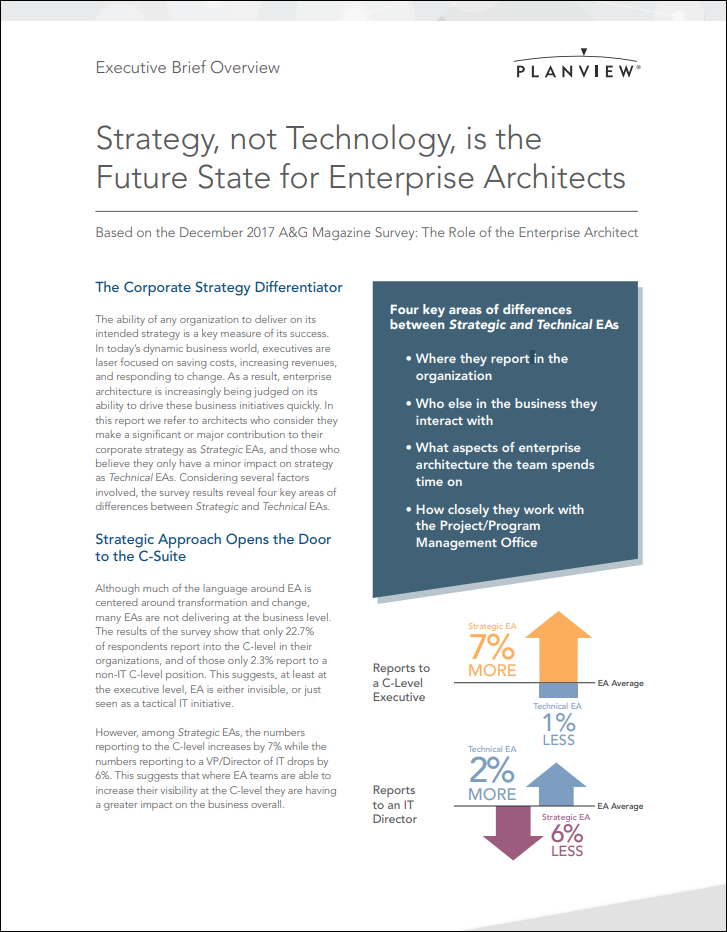
Drum roll please! I am very excited to share the initial findings from the December 2017 enterprise architecture survey titled, “The Role of the Enterprise Architect”, conducted by Architecture and Governance Magazine and commissioned by Planview. We compiled feedback from more than 200 enterprise architects from around the globe representing different industries about the state of enterprise architecture at their companies.
In a recent webinar “The Emergence of the Strategic Enterprise Architect,” I team up with Mark McGregor, 25-year veteran, author, and business coach on enterprise architecture and process management to discuss the initial findings of the survey. Together we explore how corporations can better position their enterprise architecture teams for today’s ever-changing business climate.
We segmented the many different types of enterprise architects into two groups: the strategic architect and the technical architect. Here is a simple definition:
- The technical architect is an architect who is recognized by the IT organization as a subject matter expert in a domain, helping to define and deliver technology initiatives.
- The strategic architect is recognized by the business as a key partner helping make informed decisions to realize strategy.
Key Findings
The following stats and key findings with our conclusions drawn from the data.
On average, strategic enterprise architects are 7% more likely to report to a C-level executive versus the average enterprise architect, while technical enterprise architects are only 2% likely to report to a C-level executive compared to enterprise architects overall.
Conclusion: Enterprise architects who take a strategic approach are more likely to find a seat at the C-Suite table. By having strategic conversations with the C-level you can more directly drive changes that support company objectives.
On average 39% of enterprise architects do not routinely share information with strategy, product, or sales and marketing teams within their company.
Conclusion: This is not enough interaction. To be a valuable business partner, enterprise architects needs to increase time spent with operational business teams. The interactions between customers and your business is happening between your sales, marketing, product, and strategy organizations. No one knows more about what customers want and need than these key teams.
Strategic enterprise architects are on average 14% more likely to share information with the business about corporate strategy than technical enterprise architects.
Conclusion: While technical architecture is necessary it is not sufficient. Enterprise architects must be part of the decision-making process to set the strategic direction during strategy planning. By getting involved early in the planning strategic enterprise architects help planners get the most from limited resources by identifying demand that can be consolidated, opportunities to re-use existing technology, and eliminate un-necessarily risky changes.
44% of enterprise architects said the relationship between enterprise architecture and the PMO is crucial
Conclusion: Working more cooperatively will enhance the ability of both enterprise architects and PMO teams to demonstrate business value. Business value is not realized until the changes that enterprise architect recommends are actually delivered by the PMO but the PMO can’t know what it needs to be delivered until the enterprise architecture team tells them what changes are required. They are interdependent.
65% of organizations are still using tools that are less than optimal to deliver and support enterprise architecture
Conclusion: As the operating model of Enterprise architects changes they should look at the software they are using to help them with their jobs. Traditional enterprise architect software may still be necessary but may not support emerging requirements like the desire to better share information between enterprise architecture and PMO teams.
For a deeper dive into the enterprise architecture survey findings, I invite you to listen to the webinar, “The Emergence of the Strategic Enterprise Architect” for the complete conversation and discover the five tips to become more strategic or check out the executive brief, Strategy, Not Technology, Is The Future State for Enterprise Architects.






